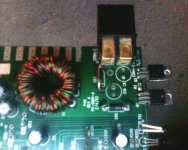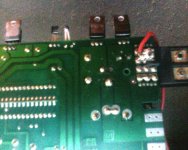You seem to be already deep into this, but did you try just moving the amp to a different location? Maybe by reorienting it you might detect a change in the interference? (I realize a small car limits mounting options.) The first step in squelching interference is to determine its source. Shotgunning can work also.
i have also used this amp in one other vehicle with a different headunit and have had the same issue. thats why it has been in my shed collecting dust until i found out the value of this generation of punch amps; these being one of the best made and what i had my hands on (the above and finding this forum).
Last edited:
Some of the old amps were tough on the primary filter capacitors. I don't think this was one of them but the caps could have taken a beating if the amp was abused. A lot of the old amps had problems with broken leads on the caps but I guess that you would have noticed that.
i didnt notice any broken leads, but i did notice the possibility of having cold solder joints on the pads on the upper side of the board underneath the cap since they solder the cap leads on both sides of the board, and where the leads are so short you cant solder the pads on top of the board directly. if the solder doesnt flow to where it contacts the top pads underneath the cap, you get a bad solder joint.
If the vias are intact, the connection will be made through them even if the solder doesn't flow to the other side of the board.
unfortunately, they werent intact in this case...
Last edited:
The pads were corroded badly (some lifted from the board when i removed the old caps) and and i would have to use longer leads to reattach the new caps to the board. this amp was abused when i got it given to me. im sorry i dont have any higher resolution pics (just the ones from the webcam on my macbook pro). the red wire is a piece of wire i connect the ground terminal to the heatsink with, since the holes the screws go through dont have any metal ground around them.Post a photo of the solder pads for the caps on the top and the bottom of the board.
Attachments
Last edited:
Here's what I think I would do. Without a schematic, I would visually and with an ohmmeter determine what needs to be connected to what. I would replace the caps, leaving them just high enough off the board so I could solder the leads on both sides of the board. Install whatever jumper wires are necessary to confirm everything is connected that's supposed to be connected. If pads are missing I might need to scrape off some solder mask with an Exacto blade to get at copper. Then I'd use double-sided foam tape, silicone, hot glue, 'Gorilla' glue, etc., whatever it took to support the caps.
Whenever I have RFI/EMI issues involving SMPS, my go to fixes are common mode chokes and or grounds. Car plate amps usually work best by using twin lead power direct to the battery (add fuse to +) . twisting wires can help here too. If it's a really badly designed unit, floating the mounting screws and using a common mode choke/s can make a difference.
RF radiation from your amp can be caused by a few things. My first thought would be bad snubber caps on the secondary windings of the transformer causing the transformer to ring. Another thought with your burnt zener. It provides an essential function, damping the voltage spikes caused by back emf from transformer primary windings preventing it from putting to much voltage across the drain and source of the mosfet. A failure mode of switching mosfets is that the internal body diode goes bad giving the back emf no other route to discharge than the zener causing it to go poof. These spikes in this case would be up to 39volts and could be radiating back into the cars electrical system. Checking for heat on the zener while it is installed in the vehicle, with the vehicle running so the amp is being fed 13.8volts and being played at full volume would be a way to check, using a pc supply simply wont feed it enough juice. I would also check the voltage on the center legs of cr4 and cr5, shouldnt be more than +-22volts with the car running. Since most of these amps were run hard into the lowest loads they could get away with, these suckers stayed pretty hot for long periods of time. I would go ahead and check the solder joints of all the 3 legged critters attached to the heatsinks.
RF radiation from your amp can be caused by a few things. My first thought would be bad snubber caps on the secondary windings of the transformer causing the transformer to ring. Another thought with your burnt zener. It provides an essential function, damping the voltage spikes caused by back emf from transformer primary windings preventing it from putting to much voltage across the drain and source of the mosfet. A failure mode of switching mosfets is that the internal body diode goes bad giving the back emf no other route to discharge than the zener causing it to go poof. These spikes in this case would be up to 39volts and could be radiating back into the cars electrical system. Checking for heat on the zener while it is installed in the vehicle, with the vehicle running so the amp is being fed 13.8volts and being played at full volume would be a way to check, using a pc supply simply wont feed it enough juice. I would also check the voltage on the center legs of cr4 and cr5, shouldnt be more than +-22volts with the car running. Since most of these amps were run hard into the lowest loads they could get away with, these suckers stayed pretty hot for long periods of time. I would go ahead and check the solder joints of all the 3 legged critters attached to the heatsinks.
i noticed that when i play this amp through a difficult load like a small sub i can hear the switching transistors make noise, like if you were listening to music through them and it is really pronounced when it's being pushed harder. what does that mean?
which ones are the snubber caps for that secondary winding of the transformer on this amp?RF radiation from your amp can be caused by a few things. My first thought would be bad snubber caps on the secondary windings of the transformer causing the transformer to ring. Another thought with your burnt zener. It provides an essential function, damping the voltage spikes caused by back emf from transformer primary windings preventing it from putting to much voltage across the drain and source of the mosfet. A failure mode of switching mosfets is that the internal body diode goes bad giving the back emf no other route to discharge than the zener causing it to go poof. These spikes in this case would be up to 39volts and could be radiating back into the cars electrical system. Checking for heat on the zener while it is installed in the vehicle, with the vehicle running so the amp is being fed 13.8volts and being played at full volume would be a way to check, using a pc supply simply wont feed it enough juice. I would also check the voltage on the center legs of cr4 and cr5, shouldnt be more than +-22volts with the car running. Since most of these amps were run hard into the lowest loads they could get away with, these suckers stayed pretty hot for long periods of time. I would go ahead and check the solder joints of all the 3 legged critters attached to the heatsinks.
is there anywhere i can get a schematic of this amp? where did you get it from?There are no snubbers according to the schematic diagram. CR6 and CR7 are the only components capable of catching spikes or ringing.
I am just going by what i can make out of the circuit by looking at pics of the pcb. You might also try looking at the cap and resistor that controls the frequency of the 494 pwm. Im guessing the power supply should be switching on the low end of the frequency range, 40-50khz. Since this amp is almost 20 years old now, the cap may have lost some of its capacitance or the resistor changed its value and has shifted the switching frequency upward.
As for hearing sound from the amp it self, it's most likely the transformer windings. This is fairly common in tube amps and probably not a real problem.
As for hearing sound from the amp it self, it's most likely the transformer windings. This is fairly common in tube amps and probably not a real problem.
i finally got the caps installed and the amp seems to sound smoother and handle difficult loads better. i have hooked it to my vehicle and played it hard and the diode doesnt get hot.
HOWEVER, I just noticed that the left channel has a static/crackle in it that comes and goes even if nothing is plugged into it (it did that before it put it in storage also; IT JUST HAD TO REAR ITS UGLY HEAD NOW!!!). when i plug the left preamp into it (or into the rear of my pioneer when the other end is connected to the amp), there is a loud pop in just that channel upon insertion of the plug (as well as when i change the station, etc; the pico fuse in the deck is fine as it doesnt do that on other amps or have the alternator whine i have heard associated with a blown pico). the crackle in that channel corresponded in rhythm with the noise in the fm. the repairs did some to the noise, but not a lot. its been very frustrating; what is the next thing to look at and/or what parts could be at fault?
HOWEVER, I just noticed that the left channel has a static/crackle in it that comes and goes even if nothing is plugged into it (it did that before it put it in storage also; IT JUST HAD TO REAR ITS UGLY HEAD NOW!!!). when i plug the left preamp into it (or into the rear of my pioneer when the other end is connected to the amp), there is a loud pop in just that channel upon insertion of the plug (as well as when i change the station, etc; the pico fuse in the deck is fine as it doesnt do that on other amps or have the alternator whine i have heard associated with a blown pico). the crackle in that channel corresponded in rhythm with the noise in the fm. the repairs did some to the noise, but not a lot. its been very frustrating; what is the next thing to look at and/or what parts could be at fault?
Last edited:
- Status
- This old topic is closed. If you want to reopen this topic, contact a moderator using the "Report Post" button.
- Home
- General Interest
- Car Audio
- old school rockford punch 40dsm messes up fm reception horribly.

